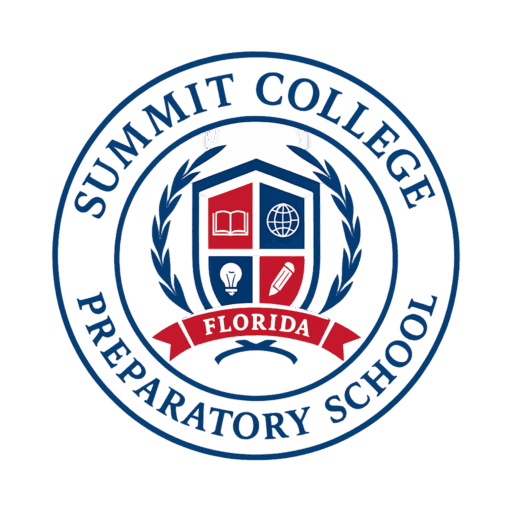English 9 (Standard)
Course Overview
English 9 is a full-year, rigorous English Language Arts course for high school freshmen that blends literary study, writing practice, speaking skills, and media analysis. This course reflects both Florida B.E.S.T. Standards and College Board readiness benchmarks for AP and SAT preparation. It is structured into four thematic units aligned to real-world themes and scaffolded academic skills.
Students develop foundational and advanced skills in reading comprehension, literary interpretation, grammar, and argument writing. The course integrates classic and contemporary works from diverse voices. Each quarter deepens exposure to genre conventions, rhetorical analysis, and synthesis of sources for academic writing. From Socratic discussions to formal research projects, students are challenged to speak, write, and think at a college-ready level.
Key themes include resilience, justice, identity, and communication. Literature ranges from canonical texts like Shakespeare’s Romeo and Juliet to modern narratives like Cisneros’ The House on Mango Street. Writing modes include narrative, expository, persuasive, and research essays. Learners engage with digital tools, peer reviews, and performance-based assessments to build academic fluency and confidence across modalities.
By the end of the course, students will demonstrate mastery of the writing process; ability to analyze texts for tone, theme, and structure; competency in delivering academic presentations; and proficiency in grammar, syntax, and vocabulary appropriate to grade 9. The course prepares students for Honors English and Advanced Placement courses in later grades.
Learning Outcomes by Quarter
- Quarter 1: Analyze literary structure, identify character motivation, and write narrative essays with sensory detail.
- Quarter 2: Interpret poetic devices, express personal voice in poetry, and engage in oral presentations on identity.
- Quarter 3: Deconstruct Shakespearean language, evaluate rhetorical strategies, and write persuasive essays.
- Quarter 4: Synthesize research findings, compare heroic archetypes, and cite sources in MLA format.
Instructional Methods
This course uses a blend of direct instruction, Socratic seminars, peer feedback workshops, and digital learning platforms. Lessons are designed to support diverse learners with differentiated instruction, scaffolded writing models, and guided reading protocols. Formative feedback is ongoing, and assessments are project-based, performance-based, and standards-aligned.
Assessment and Grading
| Category | Weight |
|---|---|
| Major Essays & Projects | 35% |
| Tests & Quizzes | 25% |
| Class Discussions & Presentations | 15% |
| Homework & Journals | 15% |
| Participation & Effort | 10% |
Anchor Text Justification
- Of Mice and Men: A seminal work for exploring friendship, power dynamics, and the American Dream. Offers accessible themes and rich character study for young readers.
- The House on Mango Street: A poetic narrative that explores identity, culture, and coming-of-age in a unique literary form. Builds student voice and personal connection.
- Romeo and Juliet: Introduces students to classical drama, iambic pentameter, and tragic structure while fostering understanding of love, fate, and family dynamics.
- The Odyssey: Examines heroism, perseverance, and literary archetypes foundational to Western literature.
- Selected nonfiction: Deepens critical thinking with essays and articles tied to themes of justice, communication, and personal growth.
College Board – SAT Crosswalk
| College Board Domain | Integrated Skills in English 9 |
|---|---|
| Command of Evidence | Close reading, textual support, research documentation |
| Words in Context | Vocabulary acquisition, context-based meaning |
| Expression of Ideas | Organization, precision, clarity, logical structure in writing |
| Standard English Conventions | Grammar practice, sentence structure, editing exercises |
Visual Elements
Each unit includes visual markers such as feather icons for writing sections, speech bubbles for discussion-based activities, and book symbols for anchor texts. These icons serve to guide student focus and signal structure for both students and reviewers.
Unit Overview
| Quarter | Unit Title | Florida B.E.S.T. Benchmarks | College Board Focus Skills |
|---|---|---|---|
| Q1 | Elements of Narrative & Literary Structure | ELA.9.R.1.1, ELA.9.R.1.3, ELA.9.C.1.3 | Theme, structure, characterization, figurative language |
| Q2 | Voice, Identity, and Poetic Forms | ELA.9.R.2.1, ELA.9.C.1.4, ELA.9.R.2.4 | Author’s purpose, literary devices, personal voice |
| Q3 | Shakespeare and Rhetorical Persuasion | ELA.9.R.3.1, ELA.9.C.3.1 | Rhetorical appeals, close reading, contextual inference |
| Q4 | Epic Journeys and Research Skills | ELA.9.C.4.1, ELA.9.C.5.1 | Research, MLA format, synthesis, cross-textual comparison |
Academic Vocabulary Matrix
| Category | Key Terms | Contextual Application |
|---|---|---|
| Literary Elements | Theme, Symbolism, Tone | Used in analyzing fiction and poetry texts |
| Rhetorical Devices | Ethos, Pathos, Logos | Applied in argumentative and persuasive essays |
| Grammar & Usage | Syntax, Parallelism, Punctuation | Practiced in revision and editing activities |
| Vocabulary Strategies | Root words, Context clues | Used in decoding unfamiliar academic language |
